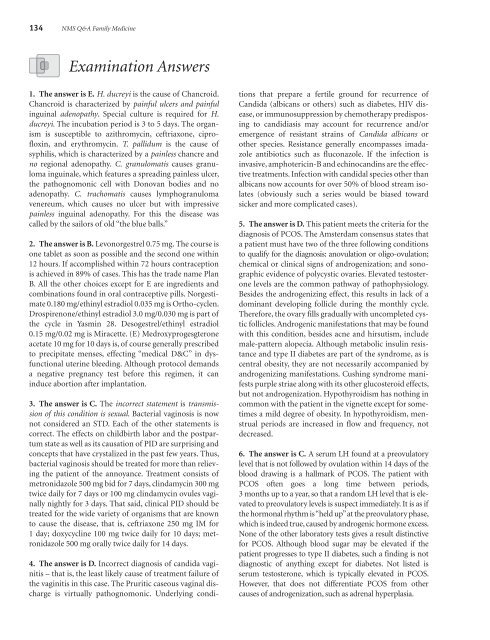NMS Q&A Family Medicine
NMS Q&A Family Medicine
NMS Q&A Family Medicine
- No tags were found...
Create successful ePaper yourself
Turn your PDF publications into a flip-book with our unique Google optimized e-Paper software.
134 <strong>NMS</strong> Q&A <strong>Family</strong> <strong>Medicine</strong>Examination Answers1. The answer is E. H. ducreyi is the cause of Chancroid.Chancroid is characterized by painful ulcers and painfulinguinal adenopathy . Special culture is required for H.ducreyi . The incubation period is 3 to 5 days. The organismis susceptible to azithromycin, ceftriaxone, ciprofloxin,and erythromycin. T. pallidum is the cause ofsyphilis, which is characterized by a painless chancre andno regional adenopathy. C. granulomatis causes granulomainguinale, which features a spreading painless ulcer,the pathognomonic cell with Donovan bodies and noadenopathy. C. trachomatis causes lymphogranulomavenereum, which causes no ulcer but with impressivepainless inguinal adenopathy. For this the disease wascalled by the sailors of old “the blue balls.”2. The answer is B. Levonorgestrel 0.75 mg. The course isone tablet as soon as possible and the second one within12 hours. If accomplished within 72 hours contraceptionis achieved in 89% of cases. This has the trade name PlanB. All the other choices except for E are ingredients andcombinations found in oral contraceptive pills. Norgestimate0.180 mg/ethinyl estradiol 0.035 mg is Ortho-cyclen.Drospirenone/ethinyl estradiol 3.0 mg/0.030 mg is part ofthe cycle in Yasmin 28. Desogestrel/ethinyl estradiol0.15 mg/0.02 mg is Miracette. (E) Medroxyprogesgteroneacetate 10 mg for 10 days is, of course generally prescribedto precipitate menses, effecting “medical D&C” in dysfunctionaluterine bleeding. Although protocol demandsa negative pregnancy test before this regimen, it caninduce abortion after implantation.3. The answer is C. The incorrect statement is transmissionof this condition is sexual . Bacterial vaginosis is nownot considered an STD. Each of the other statements iscorrect. The effects on childbirth labor and the postpartumstate as well as its causation of PID are surprising andconcepts that have crystalized in the past few years. Thus,bacterial vaginosis should be treated for more than relievingthe patient of the annoyance. Treatment consists ofmetronidazole 500 mg bid for 7 days, clindamycin 300 mgtwice daily for 7 days or 100 mg clindamycin ovules vaginallynightly for 3 days. That said, clinical PID should betreated for the wide variety of organisms that are knownto cause the disease, that is, ceftriaxone 250 mg IM for1 day; doxycycline 100 mg twice daily for 10 days; metronidazole500 mg orally twice daily for 14 days.4. The answer is D. Incorrect diagnosis of candida vaginitis– that is, the least likely cause of treatment failure ofthe vaginitis in this case. The Pruritic caseous vaginal dischargeis virtually pathognomonic. Underlying condi-tions that prepare a fertile ground for recurrence ofCandida (albicans or others) such as diabetes, HIV disease,or immunosuppression by chemotherapy predisposingto candidiasis may account for recurrence and/oremergence of resistant strains of Candida albicans orother species. Resistance generally encompasses imadazoleantibiotics such as fluconazole. If the infection isinvasive, amphotericin-B and echinocandins are the effectivetreatments. Infection with candidal species other thanalbicans now accounts for over 50% of blood stream isolates(obviously such a series would be biased towardsicker and more complicated cases).5. The answer is D. This patient meets the criteria for thediagnosis of PCOS. The Amsterdam consensus states thata patient must have two of the three following conditionsto qualify for the diagnosis: anovulation or oligo-ovulation;chemical or clinical signs of androgenization; and sonographicevidence of polycystic ovaries. Elevated testosteronelevels are the common pathway of pathophysiology.Besides the androgenizing effect, this results in lack of adominant developing follicle during the monthly cycle.Therefore, the ovary fills gradually with uncompleted cysticfollicles. Androgenic manifestations that may be foundwith this condition, besides acne and hirsutism, includemale-pattern alopecia. Although metabolic insulin resistanceand type II diabetes are part of the syndrome, as iscentral obesity, they are not necessarily accompanied byandrogenizing manifestations. Cushing syndrome manifestspurple striae along with its other glucosteroid effects,but not androgenization. Hypothyroidism has nothing incommon with the patient in the vignette except for sometimesa mild degree of obesity. In hypothyroidism, menstrualperiods are increased in flow and frequency, notdecreased.6. The answer is C. A serum LH found at a preovulatorylevel that is not followed by ovulation within 14 days of theblood drawing is a hallmark of PCOS. The patient withPCOS often goes a long time between periods,3 months up to a year, so that a random LH level that is elevatedto preovulatory levels is suspect immediately. It is as ifthe hormonal rhythm is “held up” at the preovulatory phase,which is indeed true, caused by androgenic hormone excess.None of the other laboratory tests gives a result distinctivefor PCOS. Although blood sugar may be elevated if thepatient progresses to type II diabetes, such a finding is notdiagnostic of anything except for diabetes. Not listed isserum testosterone, which is typically elevated in PCOS.However, that does not differentiate PCOS from othercauses of androgenization, such as adrenal hyperplasia.
















